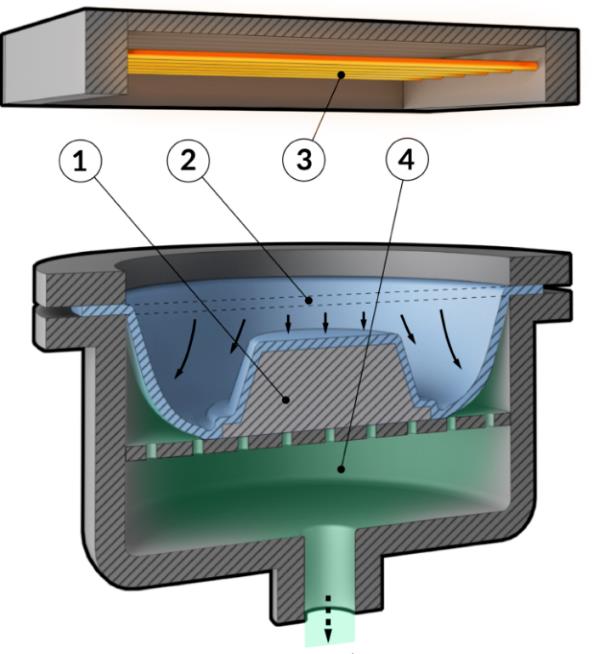Vacuum forming is a manufacturing process that shapes heated plastic sheets over molds using vacuum suction.
Vacuum Forming Process

Step-by-Step Guide to the Process
Material Preparation: Select the plastic sheet based on the product requirements. Common thicknesses range from 0.5mm to 6mm.
Heating the Plastic: Place the plastic sheet in the vacuum forming machine. Heating power ranges typically between 2kW to 10kW, ensuring the plastic becomes pliable without melting.
Molding: Once heated, the plastic is draped over the mold. The mold’s size and complexity can vary, affecting the final product’s details.
Applying Vacuum: The machine creates a vacuum, pulling the plastic sheet tightly against the mold. This step is crucial for achieving precise detailing.
Cooling and Solidification: The formed plastic cools and solidifies into shape. Cooling times vary but are crucial for maintaining the shape’s integrity.
Release and Finishing: Remove the formed product from the mold and trim any excess material. The finishing process impacts the product’s final appearance and quality.
Machinery and Equipment Used
Vacuum Forming Machine: The core equipment, which varies in size and power. Smaller machines start at 2kW, while larger industrial models can go up to 20kW.
Heating Element: Essential for softening the plastic. It must distribute heat evenly across the plastic sheet.
Vacuum Pump: Creates the vacuum needed to form the plastic against the mold. Efficiency varies based on the pump’s power and quality.
Molds: Can be made from various materials like wood, aluminum, or resin. The cost and lifespan depend on the material and complexity of the design.
Cooling System: Ensures the formed plastic cools down at an optimal rate to maintain the desired shape and quality.
Further Reading: Vacuum Forming – Wikipedia
Materials in Vacuum Forming
Overview of Commonly Used Plastics
ABS (Acrylonitrile Butadiene Styrene): Known for its strength and flexibility. Widely used in automotive and consumer goods manufacturing. Lifespan: 5-10 years.
Polystyrene: Lightweight and cost-effective, ideal for packaging. Limitation: Less durable than ABS.
Polycarbonate: Offers impact resistance and clarity. Used in protective gear and medical devices. Cost: Higher than ABS and polystyrene.
PVC (Polyvinyl Chloride): Good chemical resistance, used in plumbing and medical tubing. Noted for being flame retardant.
PETG (Polyethylene Terephthalate Glycol): Known for safety and clarity, commonly used in food packaging and medical containers.
Material Selection Criteria and Properties
Cost Efficiency: Polystyrene is budget-friendly, while polycarbonate and PETG are more expensive but offer specific benefits.
Durability: ABS and polycarbonate offer longer lifespans, essential for products in demanding environments.
Application Specifics: PETG is preferred for safe food contact and medical applications.
Environmental Resistance: PVC and polycarbonate are suitable for chemically challenging or outdoor environments.
Design Flexibility: Polycarbonate is ideal for intricate designs due to its flexibility.
Further Reading: Thermoplastic – Wikipedia
Applications of Vacuum Forming
Industrial and Commercial Uses
| Industry | Application | Materials Used | Advantages |
|---|---|---|---|
| Automotive | Interior panels, dashboards | ABS, Polycarbonate | Cost-effective for large parts, durable |
| Packaging | Blister packs, clamshells | Polystyrene, PETG | Lightweight, protective, visually appealing |
| Signage | 3D signs, display stands | Various plastics | Versatile for indoor/outdoor, eye-catching |
Unique Applications in Various Sectors
| Sector | Specific Use | Materials | Key Benefits |
|---|---|---|---|
| Medical | Device enclosures, trays | PETG, Polycarbonate | Safe, easy to sterilize, clear |
| Aerospace | Cabin components, light covers | Polycarbonate, ABS | Lightweight, contributes to fuel efficiency |
| Food Industry | Trays, containers | PETG, FDA-approved plastics | Cost-effective, food-safe, durable |
Further Exploration: Vacuum Forming in Industry – Wikipedia
Advantages and Limitations of Vacuum Forming

Benefits of Using Vacuum Forming
Cost-Effectiveness: Vacuum forming is significantly more affordable in terms of tooling costs compared to other methods like injection molding. This makes it particularly suitable for small to medium-sized production runs.
Design flexibility: The process can be adapted to a variety of shapes and sizes, providing flexibility in product design. It is capable of handling thicknesses up to 6 mm and sizes of 2 m x 3 m.
Rapid Prototyping: The lead time for developing prototypes is considerably shorter. Vacuum forming allows for quick iterations and modifications, facilitating faster product development.
Material Efficiency: The process is known for its minimal material waste, which contributes to cost savings and environmental benefits. A wide variety of thermoplastic materials can be used, enhancing the versatility of the final product.
Easy to use: The process is simple and less technically demanding, and can be used for a variety of applications, from industrial manufacturing to educational purposes.
Challenges and Limitations in Practice
Material Restrictions: Limited primarily to thermoplastic materials, the process is not suitable for items that require high-temperature resistance or extreme durability.
Dimensional Limitations: Deep or intricate parts can be challenging to form with uniform wall thickness. The process may not be suitable for parts exceeding certain depths and complexities.
Wall thickness variability of products: It can be difficult to achieve consistency in wall thickness in products with different depths, which can affect the strength and durability of the final product.
Lower Detail Precision: Compared to methods like injection molding, vacuum forming might not capture ultra-fine details, potentially requiring additional finishing work for high precision needs.
Scalability Concerns: While the method is cost-effective for small to medium-scale production, it may not be the most economical choice for very high-volume manufacturing due to longer cycle times.
For In-Depth Understanding: Vacuum Forming Process – Wikipedia




